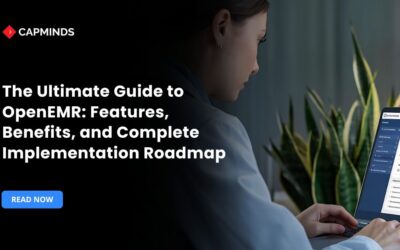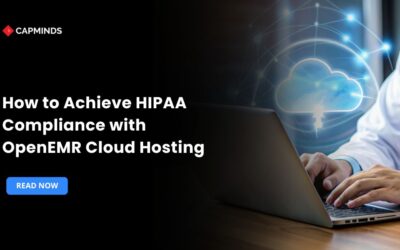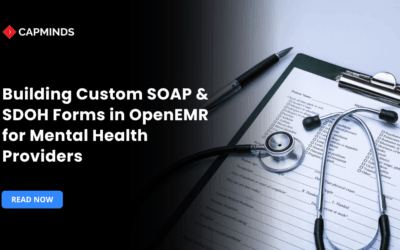From Open Source to Strategic Asset: Turning OpenEMR Into a Fully Integrated EHR Ecosystem
OpenEMR has evolved into an effective system that supports a healthcare organization’s digital strategy, having transitioned from a free manual alternative to more costly, exclusive platforms.
By expanding and integrating key modules, businesses may turn OpenEMR from a standalone outpatient charting tool to an enterprise-grade EHR ecosystem that promotes efficiency, enables new care models, and stimulates continuous innovation.
In this blog, you’ll learn how to convert OpenEMR into a fully integrated EHR system, converting an open-source system into an asset.
The Evolving Healthcare IT Landscape
1. From Monolithic to Modular Platforms
Vendor lock-in, expensive upgrades, and restricted procedures might result from using old systems. Agile, API-driven systems that can change are required for today’s telehealth, device integration, population health analytics, and patient engagement portal needs.
2. Regulatory and Standard Pressures
The demand for interoperability, such as FHIR, CCDA, meaningful use compliance, and secure data transmission, necessitates that any modern EHR work seamlessly with laboratories, imaging facilities, payers, public health registries, and patient applications.
3. Cost Control and Value-Based Care
Healthcare businesses want systems that reduce total cost of ownership, streamline revenue cycles, and provide quality measurements to support risk-sharing agreements, especially with diminishing margins and the growth of value-based compensation.
OpenEMR Strategic Advantages
1. Cost Efficiency
Licensing fees might account for up to 40% of an EHR project expense. OpenEMR eliminates these fees, allowing for greater investment in customization and services. Users can just pay for hosting, support, and iterative development, which are entirely within your control.
2. Customization and Extensibility
Each form, report, and workflow in OpenEMR is designed using PHP modules and Bootstrap templates. Organizations may customize displays for specialist processes like oncology, behavioral health, and telemedicine without relying on vendor roadmaps.
The plugin ecosystem consists of thousands of community-contributed modules, such as FHIR server, SMS appointment reminders, and RPM dashboards can expedite development and shorten time to value.
3. Interoperability and Compliance
- OpenEMR supports several standards, including HL7 communications, FHIR APIs, CCDA exports, IHE-compliant image interfaces, and ONC certification, allowing for seamless data sharing with other systems.
- OpenEMR has translation packs for over 30 languages, adjustable coding sets such as ICD-10, SNOMED CT, and flexible date/currency formats, making it ideal for multi-country deployments.
4. Scalability and Deployment Flexibility
- OpenEMR may operate in on-premises or cloud-native settings, such as a secure VMware cluster or Kubernetes on AWS for auto-scaling.
- Mission-critical uptime and smooth failovers are guaranteed via replication, load balancing, and container orchestration.
5. Robust Community Assistance
- Frequent releases are driven by an active development community, guaranteeing ongoing security updates, feature enhancements, and interaction with cutting-edge technology.
- SLA-backed managed services, training, round-the-clock support, and turnkey hosting are all offered by certified partners.
Related: Your Strategic Guide to Scaling EHR, Interop, and RCM Systems in 2025
Pillars of an Integrated EHR Ecosystem
Data Strategy and Workflow Mapping
- Conduct a thorough assessment of the present patient itineraries, healthcare workflows, and administrative procedures.
- Identify pain spots like redundant data input, paper forms, and disjointed scheduling.
- Prioritize quick-win areas like electronic intake forms and lab results automation to gain momentum.
Controlled Data Migration and Quality Assurance
- To extract outdated information, normalize fields, and correct duplicates, use ETL solutions like Pentaho, Talend, or custom Python scripts.
- Use standardized coding, such as ICD, CPT, and LOINC, and verify correctness through parallel trials before decommissioning outdated systems.
Integration Layer – APIs and Messaging
Use an enterprise service bus or interface engine such as Mirth Connect, HAPI FHIR as the foundation for all external connections, including laboratories, imaging, billing systems, government registries, and patient-facing apps. Use SMART on FHIR to provide clinical modules for integration with third-party apps and analytics.
Modern Platform Architecture and DevOps
Containerize OpenEMR services (Apache/PHP, MySQL) and set up CI/CD pipelines for automated testing, vulnerability scanning, and zero-downtime deployments. Use infrastructure-as-code (Terraform, Ansible) to maintain consistent environments from development to production.
UI/UX Modernization
Revamp the front end of patient and provider portals using responsive Bootstrap 5 themes or new JavaScript frameworks (React, Vue). Create provider dashboards that highlight crucial metrics, open orders, outstanding work, and quality measures.
Telehealth and Patient Engagement
Include secure communications, digital intake, online bill payment, and WebRTC-based video consultation modules on the patient website. Use email and SMS to automate pre-visit screenings, appointment reminders, and post-visit surveys.
Billing and Revenue Cycle Management
Automate financial reporting, electronic ERA/EOB processing, rejection management processes, and claims scrubbing by configuring OpenEMR’s billing module or integrating it with specialized RCM solutions. Reduce claim denials by utilizing the integrated CPT and ICD mapping.
Compliance and Security
- To ensure compliance, implement role-based access restrictions, audit trails, AES-256 encryption for data at rest, and TLS for data in transit.
- Set up a steering group of IT, clinical leadership, compliance, and suppliers to manage release schedules, modification approvals, and risk assessments.
Training and Adoption
- Develop a multi-tiered training program that includes on-floor clinician shadowing, executive overviews, and “superuser” deep dives.
- Use the program’s built-in tooltips and “walkthrough” assistance to help users understand new operations. Track adoption metrics like user logins, form completion times, and enhance training resources.
Track Key Performance Indicators
- Operational efficiency calculates average charting time per visit, lab turnaround times, and staff overtime hours.
- Financial metrics include cost per claim handled, claim denial rates, and revenue leakage.
- Clinical outcomes include readmission rates, preventative care compliance, and patient satisfaction scores.
Continuous optimization cycles every 3-6 months ensure that the platform adapts to your organization’s changing needs and evolving healthcare trends.
Related: Scaling OpenEMR for Multi-State Health Systems: Architecture, Compliance, and Customization Guide
CapMinds OpenEMR Customization and Integration Service
CapMinds OpenEMR equips clinicians with the best features and ways to integrate. It makes their workflows more efficient and filtered.
The integrated features will allow them to combine the ability of patient record management with conceptual and concurrent reminders.
This enhances the process of decision-making and improves patient care and quality.
- At CapMinds, OpenEMR custom solutions are developed with much care and accuracy to match the special practice needs.
- It will be low-cost and the perfect budget solution for your practice’s long-term future.
- CapMinds OpenEMR prioritizes secure data management & ensures compliance with industry regulations, offering healthcare providers peace of mind.
Get the best technologies and HIPAA-compliant and efficient OpenEMR from CapMinds that can be tailored to fit your practice.
Our OpenEMR services facilitate a Modern User Interface (UI), customization, production support, and training. They also facilitate billing, reporting, specialty enhancements, clearing house integrations, e-prescribing, and cloud services.
“Get the most experienced, proven, and perfect professional support for your OpenEMR.”




